- Volodymyr Zelensky offers to sacrifice presidential powers for Ukraine’s NATO membership, highlighting Ukraine’s geopolitical strategies.
- Donald Trump’s critiques complicate the situation, questioning democratic processes and casting doubt on NATO support for Ukraine.
- Ukraine faces relentless drone assaults, underscoring ongoing security threats and the critical role of air defense systems.
- The Kremlin emphasizes military strengthening, with Putin linking national sovereignty to increased defense capabilities.
- The situation illustrates Ukraine’s precarious position, caught between Eastern and Western influences, with leadership poised for significant sacrifices.
As Ukraine braces for the somber echoes of another anniversary of conflict, a bold proposition cuts through the tension-filled air of Kyiv. Volodymyr Zelensky, the resilient leader steering the war-weary nation, stands poised to bargain presidential power for NATO’s embrace. His audacious offer emerges like a fervent beacon amid the geopolitical storm battering Ukraine’s borders—a steadfast readiness to sacrifice his mantle if it promises Kyiv a fortified berth within NATO’s fold.
Hovering above these tense negotiations is the specter of Donald Trump, casting a formidable shadow with his caustic barbs. His biting critique singles out Zelensky as a leader dodging democracy, casting doubt on canceled electoral promises. Trump’s refusal to unequivocally support Ukraine’s NATO aspirations muddles the diplomatic waters further, as his administration appears to gravitate toward concessions favoring Russian claims—an approach met with staunch refutation in Kyiv.
Meanwhile, the rumble of drone wings multiplies in Ukraine’s skies, a stark reminder of the relentless and tactical barrages from the east. An unprecedented aerial assault—hundreds of unmanned adversaries—paint a haunting threat against Ukraine’s resolves. Air defense systems, with tireless precision, rise to the challenge, showcasing a defense stout enough to intercept and disarm, yet underscoring the perpetual danger looming.
In Moscow, the Kremlin’s corridors echo with proclamations of military strengthening, as President Putin’s rhetoric aligns sovereignty with robust martial power. The riveted focus on defense signals ambitions cloaked in a veneer of protectionism amidst global unease.
Amidst these swirling narratives, the takeaway crystallizes: Ukraine stands at a daring juncture, its leadership willing to test the bounds of personal and political sacrifice in pursuit of a guarded future, ever caught between the polar pulls of East and West.
Ukraine’s Bold Gamble for NATO Membership: The Hidden Dynamics and Future Implications
Introduction
In the seemingly perpetual conflict terrain of Ukraine, President Volodymyr Zelensky has made an audacious proposition: he is willing to barter presidential power for the prized goal of NATO membership. This strategic move highlights the dire geopolitical balancing act Ukraine must perform amid escalating tensions with Russia and the political dynamics influenced by external actors like Donald Trump, who has criticized Zelensky’s political maneuverings.
Let’s delve deeper into several areas not covered in the source material, including strategic implications, current military dynamics, and potential futures for Ukraine in the global theater.
Strategic Implications of NATO Membership
1. Defense and Security Enhancement
– NATO membership could provide Ukraine with extensive military support and heightened security assurances. The Article 5 of the NATO treaty, which calls for collective defense, would significantly deter further Russian aggression.
– Increased military training, resources, and technologies from NATO partners would further bolster Ukraine’s defense capabilities.
2. Political Sacrifices and Autonomy
– Zelensky’s offer to trade presidential power underscores Ukraine’s commitment, yet this risks domestic stability due to potential shifts in political power and governance.
– Realignment with NATO may necessitate legal and tactical reforms potentially impacting national autonomy in defense policies.
Real-World Use Cases and Trends
1. Evolving Drone Warfare
– As Ukraine contends with drone assaults, there’s ongoing collaboration within NATO on counter-drone technologies. This evolving threat requires adaptive air defense systems now shared across alliance technologies.
– The use of drones emphasizes modern warfare trends toward unmanned technologies, impacting strategies and defense spending globally.
2. Market Forecasts and Defense Industry Trends
– Ukraine’s perpetual conflict is likely to keep defense spending and arms procurement on an upward trend, influencing an increase in global defense budgets and related industries.
– The integration of NATO defense technologies is poised to stimulate industry-specific innovations within Ukraine’s existing defense sector.
Reviews & Comparisons
NATO vs. Other Defense Pacts
– Compared to other non-NATO alliances, NATO’s comprehensive military framework and rigorous defense protocols provide robust security guarantees.
– Ukraine would have significantly elevated geopolitical clout and security support compared to lesser alliances like CSTO (Collective Security Treaty Organization).
Controversies & Limitations
1. Political and Electoral Concerns
– Critics argue Zelensky’s willingness to negotiate downholds democratic values, with detractors like Trump highlighting canceled electoral promises.
– Internally, such a move could polarize public opinion, risking civil unrest if perceived as undermining national governance.
Security & Sustainability
1. Air Defense Capabilities
– With the drone threat persistent, continuous innovation and collaboration in NATO’s air defense capacity remain crucial.
– Long-term sustainability of such systems relies on balanced investments in domestic military R&D and international defense collaborations.
Actionable Recommendations
– Enhance Public Transparency: Zelensky’s administration should bolster communication with citizens, explaining the strategic benefits of NATO membership.
– Invest in Defense Education: Empower military forces through international training programs to maximize the benefits of NATO’s defense protocols.
– Maintain Diplomatic Channels: Even amidst strong national defense stances, Ukraine should maintain open dialogues with European nations enhancing synergies for peace and economic support.
For more information on NATO and its member benefits, visit NATO.
In conclusion, Ukraine’s future remains tightly knitted to both its strategic decisions and the global defense landscape. The pursuit of NATO membership may redefine Ukraine’s position, offering promising security while demanding careful political balancing.
